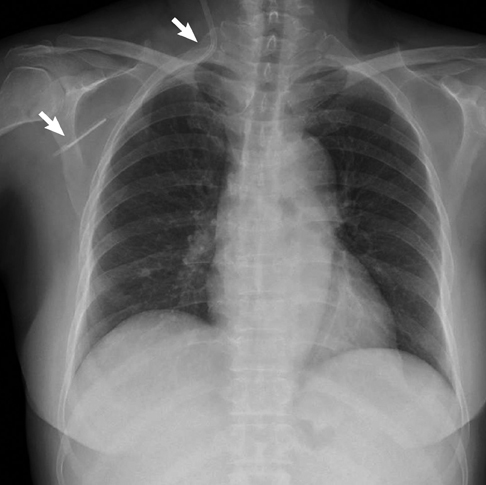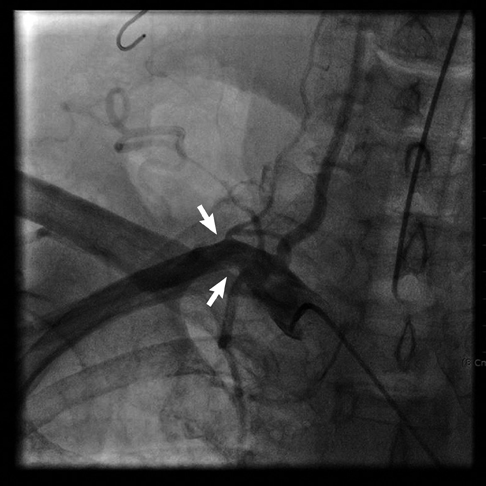J Korean Med Sci.
2012 Oct;27(10):1265-1268. 10.3346/jkms.2012.27.10.1265.
Unintended Cannulation of the Subclavian Artery in a 65-Year-Old-Female for Temporary Hemodialysis Vascular Access: Management and Prevention
- Affiliations
-
- 1Renal Division, Department of Internal Medicine, Hanyang University Guri Hospital, Guri, Korea. joohark@hanyang.ac.kr
- KMID: 1778837
- DOI: http://doi.org/10.3346/jkms.2012.27.10.1265
Abstract
- Ultrasound-guided cannulation of a large-bore catheter into the internal jugular vein was performed to provide temporary hemodialysis vascular access for uremia in a 65-yr-old woman with acute renal failure and sepsis superimposed on chronic renal failure. Despite the absence of any clinical evidence such as bleeding or hematoma during the procedure, a chest x-ray and computed tomographic angiogram of the neck showed that the catheter had inadvertently been inserted into the subclavian artery. Without immediately removing the catheter and applying manual external compression, the arterial misplacement of the hemodialysis catheter was successfully managed by open surgical repair. The present case suggests that attention needs to be paid to preventing iatrogenic arterial cannulation during central vein catheterization with a large-bore catheter and to the management of its potentially devastating complications, since central vein catheterization is frequently performed by nephrologists as a common clinical procedure to provide temporary hemodialysis vascular access.
MeSH Terms
-
Acidosis/complications
Acute Disease
Aged
Catheterization, Central Venous/*adverse effects
Female
Hemorrhage/etiology
Humans
Kidney Failure, Chronic/*diagnosis
Medical Errors/*prevention & control
Oliguria/complications
Renal Dialysis
Sepsis/etiology
Subclavian Artery/injuries/*radiography/surgery
Tomography, X-Ray Computed
Uremia/etiology
Figure
Cited by 1 articles
-
New Viewpoint of Surface Anatomy Using the Curved Sectional Planes of a Male Cadaver
Koojoo Kwon, Byeong-Seok Shin, Min Suk Chung, Beom Sun Chung
J Korean Med Sci. 2019;34(3):. doi: 10.3346/jkms.2019.34.e15.
Reference
-
1. O'neill WC. The new nephrologist. Am J Kidney Dis. 2000. 35:978–979.2. Wisborg T, Flaatten H, Koller ME. Percutaneous placement of permanent central venous catheters: experience with 200 catheters. Acta Anaesthesiol Scand. 1991. 35:49–51.3. Pikwer A, Acosta S, Kölbel T, Malina M, Sonesson B, Akeson J. Management of inadvertent arterial catheterisation associated with central venous access procedures. Eur J Vasc Endovasc Surg. 2009. 38:707–714.4. Guilbert MC, Elkouri S, Bracco D, Corriveau MM, Beaudoin N, Dubois MJ, Bruneau L, Blair JF. Arterial trauma during central venous catheter insertion: Case series, review and proposed algorithm. J Vasc Surg. 2008. 48:918–925.5. Leung J, Duffy M, Finckh A. Real-time ultrasonographically-guided internal jugular vein catheterization in the emergency department increases success rates and reduces complications: a randomized, prospective study. Ann Emerg Med. 2006. 48:540–547.6. Randolph AG, Cook DJ, Gonzales CA, Pribble CG. Ultrasound guidance for placement of central venous catheters: a meta-analysis of the literature. Crit Care Med. 1996. 24:2053–2058.7. Yonei A, Nonoue T, Sari A. Real-time ultrasonic guidance for percutaneous puncture of the internal jugular vein. Anesthesiology. 1986. 64:830–831.8. Blaivas M. Video analysis of arterial cannulation with dynamic ultrasound guidance for central venous access. J Ultrasound Med. 2009. 28:1239–1244.9. Stone MB, Hern HG. Inadvertent carotid artery cannulation during ultrasound guided central venous catheterization. Ann Emerg Med. 2007. 49:720.10. el-Shahawy MA, Khilnani H. Carotid-jugular arteriovenous fistula: a complication of temporary hemodialysis catheter. Am J Nephrol. 1995. 15:332–336.11. Patel HV, Sainaresh VV, Jaqin SH, Kute VB, Godara S, Gumber MR, Munjappa B, Gera DN, Shah PR, Trivedi HL. Cartotid-jugular venous fistula: a case report of an iatrogenic complication following internal jugular vein catherization for hemodialysis access. Hemodial Int. 2011. 15:404–406.12. McEnany MT, Austen WG. Life-threatening hemorrhage from inadvertent cervical arteriotomy. Ann Thorac Surg. 1977. 24:233–236.13. Shah PM, Babu SC, Goyal A, Mateo RB, Madden RE. Arterial misplacement of large-caliber cannulas during jugular vein catheterization: case for surgical management. J Am Coll Surg. 2004. 198:939–944.14. Nicholson T, Ettles D, Robinson G. Managing inadvertent arterial catheterization during central venous access procedures. Cardiovasc Intervent Radiol. 2004. 27:21–25.15. Brown CQ. Inadvertent prolonged cannulation of the carotid artery. Anesth Analg. 1982. 61:150–152.16. Basile A, Calcara G, Rapisarda F, Fatuzzo P, Desiderio C, Granata A, Patti MT. Aberrant right subclavian artery laceration due to internal jugular vein catheterization treated by stent-graft implantation. J Vasc Access. 2010. 11:80–82.17. Yu H, Stavas JM, Dixon RG, Burke CT, Mauro MA. Temporary balloon tamponade for managing subclavian arterial injury by inadvertent central venous catheter placement. J Vasc Interv Radiol. 2011. 22:654–659.18. Sharma M, Sakhuja R, Teitel D, Boyle A. Percutaneous arterial closure for inadvertent cannulation of the subclavian artery--a call for caution. J Invasive Cardiol. 2008. 20:E229–E232.19. Chemelli AP, Wiedermann F, Klocker J, Falkensammer J, Strasak A, Czermak BV, Waldenberger P, Chemelli-Steinguber IE. Endovascular management of inadvertent subclavian artery catheterization during subclavian vein cannulation. J Vasc Interv Radiol. 2010. 21:470–476.20. Barsuk JH, McGaghie WC, Cohen ER, O'Leary KJ, Wayne DB. Simulation-based mastery learning reduces complications during central venous catheter insertion in a medical intensive care unit. Crit Care Med. 2009. 37:2697–2701.
- Full Text Links
- Actions
-
Cited
- CITED
-
- Close
- Share
- Similar articles
-
- Endovascular Repair Using Suture-Mediated Closure Devices and Balloon Tamponade following Inadvertent Subclavian Artery Catheterization with Large-Caliber Hemodialysis Catheter
- Hydrohemothorax and Subclavian Artery Laceration during Internal Jugular Vein Cannulation: A case report
- Thrombotic obstruction of the subclavian artery associated with inadvertent arterial puncture on attempted right internal jugular vein cannulation: A case report
- Total Arch Replacement for Chronic Aortic Aneurysmal Dissection Patient with Aberrant Subclavian Artery
- Recurrence of Coronary-Subclavian Steal Syndrome After Successful Angioplasty of Malfunctioning Arteriovenous Fistula




